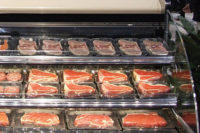The actual frequency and tasks performed for each system will vary from system to system. Always refer to the manufacturers’ guidelines for their maintenance requirements. However, below are some generic maintenance tasks which can be applied to many refrigeration systems. These tasks can be divided into two groups: one for maintaining the cabinet and one for maintaining the refrigeration system.
MAINTAINING CABINETS
Maintaining the refrigerated cabinets is definitely an important part of the program. Their doors need to be inspected regularly. Rubber door gaskets tend to rot quicker when caked with food and grime. They can be safely cleaned with a solution of baking soda and warm water. Larger doors such as the ones used on walk-ins will normally have a sweep. Be sure to inspect the sweep for damages and replace as needed.Be sure to also clean, inspect, and lube the door hinges. Apply a bit of petroleum jelly to keep them working well. Verify the door closes properly and does not “pop” open. When working on walk-ins, also check the door latch and verify the door can be opened from the inside. This is a major safety checklist item. If a door closure is used, check to make sure it is operational.
Also check for any water, ice, or frost which may have collected within the cabinet. Water, ice, or frost collecting under the evaporator or the base of the cabinet may be the result of a condensate drain issue or some type of defrosting problem. Ice or frost on a door jam is usually an indication of a defective door heater or door gasket.
MAINTAINING REFRIGERATION SYSTEMS
Maintaining the refrigeration system is the second part of the program. First, check the case temperature. Generally medium temperature coolers should maintain a case temperature between 35 to 40°F and low temperature cases below 0°. If temperatures above these values are noticed, the cause needs to be determined and resolved. On medium temperature coolers, temperatures below 35° also indicate an issue which needs to be corrected.Inspect the refrigerant lines for any oily locations and any missing or damaged insulation. Any missing or damaged insulation should be replaced. An oily refrigerant line can be the result of a refrigerant leak. The oily location needs to be examined more closely to discover the reason.
All electrical wiring and connections needs to be examined. Look for signs of any loose or overheated conductors or connections and replace or tighten as needed.
Both the evaporator and condenser coils need to be inspected and cleaned, as required. Also make sure the airflow to and through these coils are unrestricted. Also inspect and clean, as needed, any fan blades and fan covers. If applicable, oil any motors as required. Look for any frost or ice on the evaporator coil. Heavy frosting is normally an indication of a defrosting issue.
On small refrigeration systems, checking the system’s pressure is not necessary; in fact, it may even cause an issue. Small systems have a small refrigerant charge. Any loss of refrigerant can cause the system to operate inefficiently and if enough refrigerant is lost, it might not operate at all.
There are two issues technicians must deal with when working on these small systems. First, they may not have any access ports to check the system’s pressure. If this is the case, a technician needs to add a port. If not installed properly, it can cause refrigerant to leak from its connection. Even a small leak is a problem.
The other issue is the amount of refrigerant lost each time a technician attaches the manifold hoses. A little refrigerant is lost each time a hose is attached and removed. The longer the hose, the more refrigerant is lost. The smaller the system, the more critical this loss of refrigerant becomes. So the best practice when dealing with small systems is not to attach your manifold gauges unless the system is not working properly and you need to diagnose a problem. If the system is working properly, leave it alone.
Some technicians may check the system’s suction or discharge temperature. If excessive, they will examine the system closer. When dealing with larger systems that have access ports, checking the system’s pressures, temperatures, superheat, and sub cooling values is a good practice and will not cause an issue with the small amount of refrigerant lost.
Regularly maintaining refrigeration systems is definitely a plus for technicians and their customers. It should be a regular part of any contracting business and its importance demonstrated to their customers.
Publication date:01/17/2011






